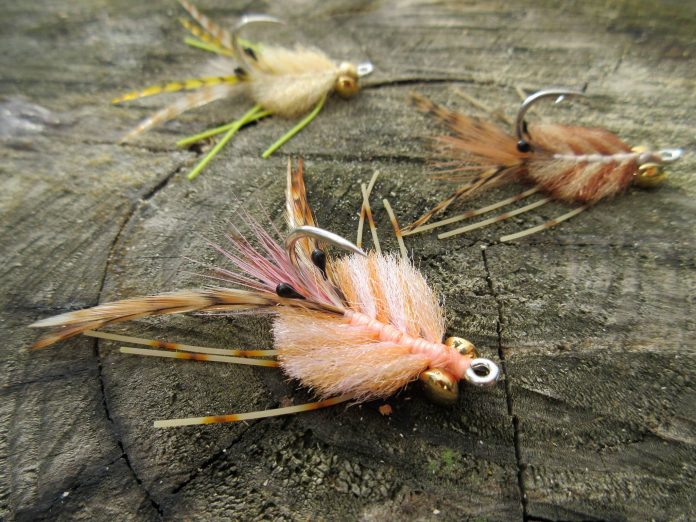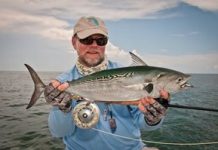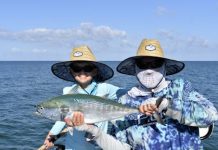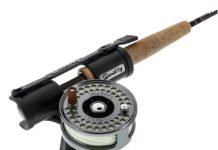 Many of my clients are freshwater trout fisherman from the north, west and Midwest who are trying saltwater fly fishing for the first time. Their experience level varies from a few years of fly fishing to decades of pursuing Brook, Brown and Rainbow trout. One of the things they all share is that the heaviest rod they ever held is the one I just handed them.
Many of my clients are freshwater trout fisherman from the north, west and Midwest who are trying saltwater fly fishing for the first time. Their experience level varies from a few years of fly fishing to decades of pursuing Brook, Brown and Rainbow trout. One of the things they all share is that the heaviest rod they ever held is the one I just handed them.
If they have fished for Bass or Salmon and Steelhead, a seven weight rod might be their heaviest, but many have never fished with anything heavier than a five weight. If small streams are their normal interest, casts of more than thirty feet have never been attempted. How does this prepare them for their first saltwater experience?
A lot depends on what they want to catch. If Trout and Ladyfish on the flats are their desire, there will not be a problem. Most conversations I have, center on Redfish in skinny water, Snook and Tarpon. Rods for Redfish and Snook could be up to a nine weight, Tarpon a twelve. Long casts are necessary for Redfish and Tarpon especially. In order to cast far, a number of things must be accomplished before the fly lands within the fish’s strike zone.
Did they take the time to practice at home before coming here to fish? A local fly shop will have heavier rods and usually someone who could help them with their goal, which should be to cast with some degree of efficiency and accuracy at the distances needed for their quarry.
All sportsman who excel, execute fundamentals with a minimum of error. The Federation of Fly Fishers, has a booklet entitled, “The Essentials of Fly Casting.” These five essentials, when properly executed will result in fly casting proficiency. They apply weather you are using a three weight or a twelve weight.
There must be a PAUSE at the end of each stroke, which varies in duration with the amount of line beyond the rod tip. When fly casting, the weight of the line, not the fly, bends or loads the rod. A pause is needed to allow the line to straighten between the backward and forward cast, thus loading the rod. Failure to do this will result in a sloppy cast.
SLACK LINE must be kept to an absolute minimum. What causes slack? Movement of the fly line by outside forces such as wind or water, starting the cast with the rod tip too high, rough, jerky application of power, and poor timing between the backward and forward cast. The belly of line that forms when the rod tip is held too high at the beginning of a cast is the most common.
In order to form the most efficient, least air resistant loops, and to direct the energy of a fly cast toward a specific target, the caster must move the rod tip in a STRAIGHT LINE PATH. The loop refers to the shape of the fly line during the cast. A tight or good loop is where the top and bottom strands of line are relatively close together. The larger the loop, the more air resistant and inefficient the cast will be, resulting in a loss of energy. If the top strand of fly line drops below the bottom strand, a tailing or crossed loop will result. This is always a fault in fly casting and causes “wind knots” in line or leader.
The SIZE OF THE CASTING ARC must vary with the length of line past the rod tip. A short line requires a narrow casting arch, a long line, necessitates a longer one. The casting arc is the angle between the rod at the beginning of the casting stroke and at the end of the stroke. The casting stroke is the movement of the hand and arm to apply power to the rod. The backward and forward movement of the rod during false casting is an example.
POWER must be applied in the proper amount at the proper place in the stroke. Power is applied slowly at first, gradually increasing to a peak at the end of the stroke. The amount of power needed for each cast is influenced by a number of factors including the amount of line to be false cast, the total length of the cast, the wind direction, the weight of the rod and line, and the type of cast to be made. Lefty Kreh refers to this as, “a speed up and stop.”
Julie Nelson, a FFF staff member, gave me permission to use their booklet as a source for this article. Their website is www.fedflyfishers.org.
Capt. Pat Damico
St. Pete Beach
www.captpat.com
- Captain’s Corner:Pat Damico - June 25, 2019
- Flat water makes seeing tarpon easier - May 17, 2017
- Warm rivers holding plenty of targets for fly fishermen - February 16, 2017











